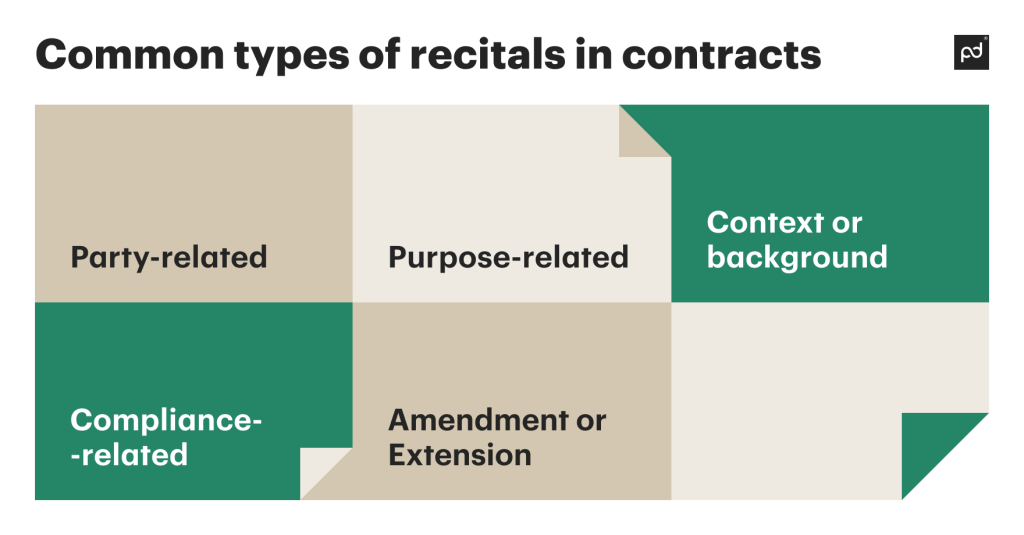Contract recitals are statements that provide background information about the intent of a contract.
They are located in the introductory part of a contract and immediately follow any preambles listed (though some in the legal profession consider preambles and recitals to be one and the same).
Although they are not legally binding, courts often refer to recitals for interpreting contract’ purposes and parties’ intent.
This article aims to help you understand the role of recitals in a contract and assist you in drafting them.
Key takeaways
- A traditional method of drafting contract recitals is to use the “Whereas” wording at the beginning of a sentence and maintain a formal tone of voice.
- A modern approach to composing contract recitals includes plain and conversational language, active voice, and short sentences.
- Recitals in a contract should be limited to intentions and statements of facts, and exclude any obligations, conditions, or warranties.
- Contract recitals are not legally binding on their own; however, they can be used to interpret the contracts’ intentions in case of a dispute in the operative clauses.
What are contract recitals?
Contract recitals explain the reasons for the execution of a contract and present introductory remarks about the parties involved.
Recital clauses typically consist of one to five paragraphs, but the number of recitals depends on the complexity of the contract.
For example, real estate or settlement agreements may include dozens of recitals referencing facts, events, and each party’s point of view.
Historically, recitals in commercial contracts often begin with the wording Whereas, which means given the fact that.
This wording is leftover from an era when lawyers used seemingly big words to try and impress their clients with their intellect.
The modern contract drafting style has shifted toward a more conversational approach, often omitting the “Whereas” clauses.
Nevertheless, many legal and formal documents still retain the traditional formatting style.
Common types of recitals in contracts

Party-related recitals
These recitals reference details about the parties involved in a transaction, which can include legal names, addresses, or simply the type of company and information about their location.
WHEREAS, Party A is a foreign-owned product company formally established and existing in accordance with the laws of the state of California, and it has the relevant resources to provide services to Party B.
Purpose-related recitals
This type of recital outlines the reasons for entering into the contract, as well as the objectives or goals the parties intend to achieve.
WHEREAS, Party A and Party B hereto intend to collaborate on a brand relaunch project to redesign Party B’s corporate website and enhance Party B’s website performance.
Context or background recitals
These describe the chronological account of events or circumstances which led to the transaction.
WHEREAS, in 2023, Party A has developed HR automation software with automation features, and Party B has expressed a strong interest in utilizing this software to optimize business processes.
Compliance-related recitals
This type establishes the context regarding compliance with specific laws, regulations, or industry standards.
WHEREAS, both parties are committed to complying with the GDPR and ensuring data protection in their activities.
Recitals for amendment or extension
In contracts that amend or extend existing agreements, recitals may reference the original contract and explain the reasons for the amendment or extension.
NOW, THEREFORE, Party A and Party B enter into this Sales Agreement Extension, which extends the pricing terms specified in the Original Agreement for an additional twelve (12) months, starting on January 1, 2023, and ending on December 31, 2023.
A library of free contract templates will help you start the drafting process faster.
These templates come with an outline, including some with a section dedicated to recitals, and formatting that you can adjust with your information.
Tips for writing contract recitals
Given that contracts vary and each has its unique background story, here are some pointers to assist you in getting recitals done right.
1. Write recitals first, then move to operative clauses
Writing contract recitals is like telling the beginning of a story.
You first form an outline, then move to the body of the text. The same applies to contract recitals.
Formulate recitals in your own words, and then start polishing them with details and facts that lead to a transaction.
Validate all facts and dates to prevent misunderstandings and ambiguities in the contract.
A tool that can make the drafting process smoother is a contract management system. You can create a contract from scratch or upload your own.
In the editor, you can collaborate with parties or other contract collaborators, tag specific clauses, and track changes to see when and by whom those changes were made.
2. Identify the parties, purpose, and intent of a contract
The checklist below is to help you cover the background story behind your contract to the fullest.
- Introduce the contracting parties with details about their business and the nature of their work;
- Identify subject matter of the contract and add recitals explaining why the agreement is being entered, who was approached by whom, and what the story is behind the agreement;
- Describe the offer and acceptance part of the contract — what was offered, agreed upon, etc;
- Provide information about documents or payments that were previously put into execution;
- Describe the parties’ intent to sign a contract.
3. Do not make any obligations, conditions, or warranties
When drafting contract recitals, limit them to intentions and statements of facts only.
Contract recitals don’t have legal authority over the contract provisions.
If operative clauses are placed in the recitals section, it may confuse the court and parties if the provisions are legally binding or just explanatory.
The same rule applies to key definitions within a contract, so be sure you place them in the main contract body.
4. Stick to one type of formatting and language
There is a distinction between traditional and modern formatting.
The traditional method means that contract recitals are composed of continuous sentences with several clauses in one.
The modern approach, on the other hand, involves changing contract recitals to short and complete sentences written in an active voice.
When drafting recitals, remember to exclude adjectives that express subjective opinions, and avoid using slang when describing the subject matter to prevent potential confusion.
Keep the goal in mind: Making a contract easy to read for those whom these agreements are drafted.
If you have difficulties formulating recitals, apply the KISS principle — Keep It Simple and Straightforward — to your writing process.
End each recital with a full stop rather than a bullet point or a semicolon.
After creating a contract, the final step is to securely store it. You can do that in PandaDoc’s contract management system, which provides a document repository with controlled access and permission-based user roles. You can organize contracts with filters and find them in seconds.
When are the recitals likely to be admissible?
In cases when the operative clauses are not clear and there is an ambiguity, the court or an arbitration hearing might rely on recitals to clarify the contract interpretation.
To ensure admissibility, you can also include a clause in the operative part stating that “The recitals above are a part of the Agreement.”
What should I do to ensure that the recitals are taken into consideration?
To ensure your recitals are considered in the proper context, draft them carefully and align them with the correct formatting.
Ensure that they are based on validated facts.
Place recitals at the beginning of a document, before the body of the text.
If you refer to specific terms in the recital section, make sure their definitions match with those in the provisions clause.
Finally, you can provide references to some recitals within the operative provisions. For example, you may state that the parties’ obligations are based on the recitals.
Can the contract recitals be ineffective?
The recitals can be ineffective in two cases.
First — if the recitals are ambiguous, but the operative clauses are clear, then the main body would be considered authoritative.
Second — if both sections (recitals and operative clauses) are clear but inconsistent with each other, the operative part will be the one with leading authority.
What is the difference between preamble and recitals?
The preamble to a contract identifies the parties to an agreement, while recitals explain the reasons why the parties are entering into an agreement and what their intent is.
The preamble section typically appears as the first paragraph in the contract, with the recitals placed after it.
Final thoughts
While contract recitals are not mandatory for every contract, they are worth considering when drafting one.
By incorporating them, you ensure clarity and provide context behind a contract, and you also safeguard yourself and the parties involved by establishing a common understanding.
Not to mention the fact that when there is clarity and no disputes around a contract, you streamline the entire contracting process.
Schedule a 15-minute demo to see how PandaDoc can help you in creating, organizing, and managing contracts.
Disclaimer
PandaDoc is not a law firm, or a substitute for an attorney or law firm. This page is not intended to and does not provide legal advice. Should you have legal questions on the validity of e-signatures or digital signatures and the enforceability thereof, please consult with an attorney or law firm. Use of PandaDocs services are governed by our Terms of Use and Privacy Policy.


